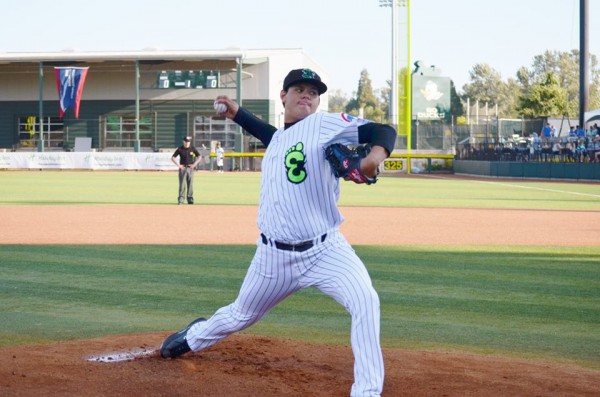Yes, Rob Zastryzny and Jen-Ho Tseng have each filled in, but the Cubs in the Theo Era have not yet developed one permanent starting pitcher for the rotation. Through six drafts and six International Free Agent signing periods, nothing. Simply put, why have the Cubs failed, so far, to produce big league pitching on their own?
Let’s begin with the precept that the pitching cupboard was pretty bare in the fall of 2011 when Theo took over. Of the top 10 prospects in the Cubs system in 2011, the Cubs had five pitchers listed. Not one of them was in the organization two years later. Only reliever Chris Carpenter sniffed the big leagues.
Developing pitching is not easy. According to Theo Epstein, pitching can take anywhere from 5-7 years to develop. That development time frame window is now opening for many of their first draft class. Conversely, both Jed Hoyer and Jason McLeod have commented about how hitting is much more projectable at the top of the draft. Every first round hitting prospect taken by the Cubs is in the majors. Point taken.
It is not as if the Cubs have avoided selecting pitchers. They have taken lots of them, just not in the first round until 2017. Some have been good value picks as Dillon Maples was a 14th rounder taken by Jim Hendry in 2011 while Trevor Clifton was a 13th rounder in 2013, and Zach Hedges was taken in the 26th round in 2014.
Still not one of them is starting in Chicago in the foreseeable future. Duane Underwood is close, but he has not been dominant for the better part of two years. He still throws hard, he just has command issues.
In 2016, the Cubs signed 15 drafted pitchers, and 12 are still in the system. In 2017, the Cubs signed 19 more of them – some are starters, some are relievers. Thomas Hatch, Duncan Robinson, and Michael Rucker are three 2016 picks who will be at Double-A to begin 2018.
Here are the questions that need to be answered when it comes to developing pitchers.
Is this a systemic issue? Is there something the organization is doing developmentally that is having unintended consequences?
If anything, the Cubs are highly protective of their pitching assets. The pitchers are on a six day schedule until Double-A where they go to five days. In talking with the players at the lower levels, they always have high praise for coaches David Rosario, Brian Lawrence, and Anderson Tavarez, so an organization issue doesn’t seem to be the case.
Why are several pitchers flaming out at AA?
The change to a five-man rotation is huge. There are more starts, more innings, more pitches, and more stress on the arm. An average MLB pitcher throws between 160-200 innings a year, and the Cubs try to build up to that. By Double-A, the arms should be between 130-160 innings. Very few get there. Duane Underwood finally did this year, but the hot prospect in the system, Adbert Alzolay, only hit 114.1 IP this past year. To pick on this issue would be trivial as many organizations use six-man rotations in the lower minors. On the other hand, the change at Double-A is transformative.
Is the inability to develop a starting pitcher a scouting issue? Are the Cubs not willing to spend money on pitching?
Right now, on MLB Pipeline, the Cubs top three prospects are pitchers who are all International Free Agents. The rise to prominence of Jose Albertos, Oscar de la Cruz, and Adbert Alzolay is a testament to scouting and development. Oscar used to be a shortstop while Albertos was only 16 when signed as a pitcher out of Mexico as was Alzolay out of Venezuela.
Then why haven’t the Cubs developed a starter yet?
Most pitchers that play in MLB were selected in the first four rounds of the draft. For the Cubs, their emphasis since day one of the Theo Era has to been to select hitters. Some of the pitchers the Cubs took in the upper parts of the draft the past five years have been gambles. Zastryzny and Jake Stinnett fit that bill, for instance.
Tyler Skulina, Carson Sands, Justin Steele, Preston Morrison, and Kyle Twomey were players with pedigrees of experience and talent when they were taken. Things have not worked out according to plan. Skulina was hampered by injuries. Sands has been battling elbow splints and other assorted injuries since June 2016. Steele was having a great 2017 season in Myrtle Beach before Tommy John surgery in August ended his season. Morrison was brilliant at both stops in A ball. He was outstanding in May this year as a starter in Tennessee and then struggled even out of the pen in the second half.
Part of the Plan
On the other hand, this has been by design. And “by design,” I mean the Cubs targeted projectable hitters at the top of the draft and not pitchers. In doing so, the Cubs gambled that they could get pitching via free agency and trades. And that is exactly what they did. In fact, they won a World Series doing that.
The five-to-seven year window espoused by Epstein is important to remember as players like Duane Underwood and Jen-Ho Tseng are now in those time frames and both are still 23 years old (they both seem like they have been around forever). Maybe, as fans, we are being a little impatient. In this rebuild, fans have had instant access to prospect performance and analysis. MiLB.TV transformed how the minor leagues are seen. Blogs and websites regularly have updates on the minors. Nothing is hidden.
Five to seven years is a long time in the life of a fan, but it is a normal period to develop a pitcher. Fast track prospects are the exception, but the pitchers are getting close now. Very close.
Lead photo of Jose Albertos courtesy Eugene Emeralds
